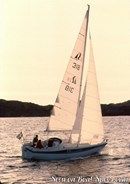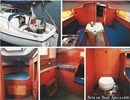Hallberg-Rassy 26
Sailboat specifications
The Hallberg-Rassy 26 is a 26’1” (7.95m) cruising sailboat designed by Olle Enderlein (Sweden). She was built between 1978 and 1985 by Hallberg-Rassy (Sweden) with 469 hulls completed.
Hallberg-Rassy 26's main features
- Model
- Hallberg-Rassy 26
- Hull type
- Monohull
- Category
- Cruising sailboat
- Sailboat builder
- Sailboat designer
- Country
- Sweden
- Construction
- GRP (glass reinforced polyester):
- Hull: Single skin fiberglass polyester
- Deck: Sandwich fiberglass polyester - Number of hulls built
- 469
- First built hull
- 1978
- Last built hull
- 1985
- Appendages
- Keel : fin without bulb
- Helm
- Single tiller
- Rudder
- Single transom hung rudder
- Unsinkable
- No
- Trailerable
- No
- Standard public price ex. VAT (indicative only)
- N/A €
Hallberg-Rassy 26's main dimensions
- Hull length
- 26’ 1”7.95 m
- Beam (width)
- 8’ 10”2.68 m
- Draft
- 4’ 7”1.4 m
- Mast height from DWL
- 39’ 5”12 m
- Light displacement (MLC)
- 5512 lb2500 kg
- Ballast weight
- 2425 lb1100 kg
- Ballast type
- Steel incapsulated in deep GRP bilge
Hallberg-Rassy 26's rig and sails
- Upwind sail area
- 400 ft²37.2 m²
- Downwind sail area
- 652 ft²60.6 m²
- Mainsail area
- 177 ft²16.4 m²
- Genoa area
- 224 ft²20.8 m²
- Jib area
- 167 ft²15.5 m²
- Stormjib area
- 56 ft²5.2 m²
- Symmetric spinnaker area
- 476 ft²44.2 m²
- Rigging type
- Sloop Marconi 7/8
- Mast configuration
- Deck stepped mast
- Rotating spars
- No
- Number of levels of spreaders
- 1
- Spreaders angle
- Swept-back
- Spars construction
- Aluminum spars
- Standing rigging
- 1x19 strand wire
Hallberg-Rassy 26's performances
- Upwind sail area to displacementiThe ratio sail area to displacement is obtained by dividing the sail area by the boat's displaced volume to the power two-thirds.
The ratio sail area to displacement can be used to compare the relative sail plan of different sailboats no matter what their size.
Upwind: under 18 the ratio indicates a cruise oriented sailboat with limited performances especially in light wind, while over 25 it indicates a fast sailboat. - 217 ft²/T20.2 m²/T
- Downwind sail area to displacementiThe ratio sail area to displacement is obtained by dividing the sail area by the boat's displaced volume to the power two-thirds.
The ratio sail area to displacement can be used to compare the relative sail plan of different sailboats no matter what their size. - 354 ft²/T32.9 m²/T
- Ballast ratioiThe Ballast ratio is an indicator of stability; it is obtained by dividing the boat's displacement by the mass of the ballast. Since the stability depends also of the hull shapes and the position of the center of gravity, only the boats with similar ballast arrangements and hull shapes should be compared.
The higher the ballast ratio is, the greater is the stability. - 44 %
Hallberg-Rassy 26's auxiliary engine
- Engine(s)
- 1 inboard engine
- Engine(s) power
- 7 HP
- Fuel type
- Diesel
- Fuel tank capacity
- 10.6 gal40 liters
Hallberg-Rassy 26's accommodations and layout
- Cockpit
- Aft cockpit
- Freshwater tank capacity
- 17.2 gal65 liters
- Fridge/ice-box capacity
- 18.5 gal70 liters
- Head headroom
- 5’ 2”1.6 m
Hallberg-Rassy 26's saloon
- Saloon table length
- 3’0.9 m
- Saloon table width
- 2’ 4”0.7 m
- Berth length
- 6’ 7”2 m
Hallberg-Rassy 26's fore cabin
- Berth length
- 6’ 7”2 m
- Berth width
- 5’ 2”1.6 m



Hallberg-Rassy 26 sailplan - - 2/10
Picture extracted from the commercial documentation © Hallberg-Rassy
Picture extracted from the commercial documentation © Hallberg-Rassy


Hallberg-Rassy 26 layout - - 3/10
Picture extracted from the commercial documentation © Hallberg-Rassy
Picture extracted from the commercial documentation © Hallberg-Rassy


Hallberg-Rassy 26 sailing - - 4/10
Picture extracted from the commercial documentation © Hallberg-Rassy
Picture extracted from the commercial documentation © Hallberg-Rassy


Hallberg-Rassy 26 sailing - - 5/10
Picture extracted from the commercial documentation © Hallberg-Rassy
Picture extracted from the commercial documentation © Hallberg-Rassy


Hallberg-Rassy 26 sailing - - 6/10
Picture extracted from the commercial documentation © Hallberg-Rassy
Picture extracted from the commercial documentation © Hallberg-Rassy


Hallberg-Rassy 26 sailing - - 7/10
Picture extracted from the commercial documentation © Hallberg-Rassy
Picture extracted from the commercial documentation © Hallberg-Rassy


Hallberg-Rassy 26 sailing - - 8/10
Picture extracted from the commercial documentation © Hallberg-Rassy
Picture extracted from the commercial documentation © Hallberg-Rassy


Hallberg-Rassy 26 interior and accommodations - - 9/10
Picture extracted from the commercial documentation © Hallberg-Rassy
Picture extracted from the commercial documentation © Hallberg-Rassy


Hallberg-Rassy 26 interior and accommodations - - 10/10
Picture extracted from the commercial documentation © Hallberg-Rassy
Picture extracted from the commercial documentation © Hallberg-Rassy
Similar sailboats that may interest you:
Sailboats
First built hull
Hull length
1977
38’11.57 m
1981
30’ 10”9.4 m
1979
30’ 11”9.42 m
2015
29’8.83 m
1965
27’ 1”8.25 m
1966
23’ 4”7.1 m
1969
28’ 11”8.8 m
1961
22’ 7”6.9 m
1982
24’ 7”7.5 m
2005
24’ 6”7.47 m
1975
26’ 2”8 m
1984
24’ 11”7.6 m
2007
25’ 7”7.79 m
2012
31’ 1”9.48 m
1977
23’ 7”7.2 m